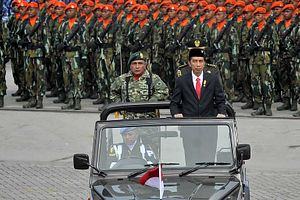If ever there was a sign of changed public perceptions of the Indonesian military (Tentara Nasional Indonesia or TNI) since former President Suharto declared the New Order in 1966, you need not look further than the Army’s 2012 flashmob dance in the capital, Jakarta. Organized on a busy Sunday, around 200 camouflage-clad soldiers from the Army’s Strategic Command (KOSTRAD) descended upon Jakarta’s central roundabout and performed a choreographed dance that ended with the global K-pop hit Gangnam Style. In one of the world’s most social-media savvy cities, onlookers captured footage of soldiers smiling and posing with environmental activists and Cabinet Ministers at the famous landmark.
This PR-friendly force is a far cry from the military that cracked down violently on student protesters in the capital in the dying days of the Suharto regime.
The Indonesian military today has made a remarkable transformation over the past 18 years. It is far more professional as a military force and is increasingly better equipped (though having started from a low base). It has also grown more confident in training and exercising with foreign partners. The military’s orderly exit from politics, drawdown of its business activities, and fervor for reform during the B.J. Habibie era (which eased the country into democracy just after the 1998 end of the Suharto regime) have contributed to the further professionalization of the force. A 2015 survey conducted by the Jakarta-based Center for Strategic and International Studies Indonesia found that 90 percent of respondents ranked TNI as the most trusted institution, relegating the national Corruption Eradication Commission (KPK) to second place.

































